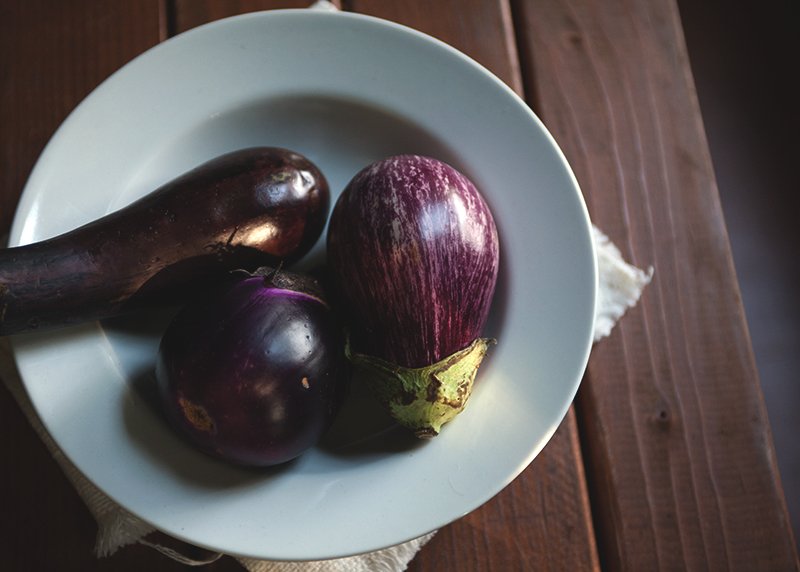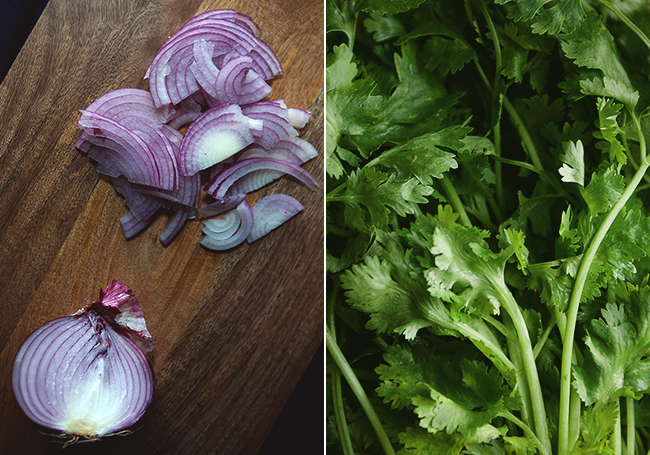On lazy evenings, when dinner is only an afterthought, my parents like to steam eggplant until it’s soft. Until it became a soggy pulp, it always seemed to me, whose eggplant taste had been diluted to the point of extinction. Needless to say, growing up, I dreaded the sight of the bamboo steamer. (Actually, that’s not true at all. I love the steamer. It’s my favorite kitchen “utensil” because it makes possible the steaming of pork buns and sticky rice and eggs. But the steamer figured largely in bland suppers, so I was ambivalent.)
Alternatively, my dad, who is very forthcoming with oil, took great joy in frying eggplant up in the wok “yu xiang” style. That roughly translates to “fish-flavored,” a name that always mystified me because there is nothing fishy about the flavor. He would pour a nice deep layer of oil in the wok, turn the heat up high, and, when the oil was bubbling and snapping, hungry-fish-like, toss all the ingredients in, quick, stirring vigorously and with enough fervor so that everything cooked perfectly. The eggplant blistered and melted into succulent bites, all made possible by the oil. “The only thing eggplant is good for is soaking up oil,” my mom would say in disgust. She refused to eat this dish.
Because it’s true—these strange cylindrical bulbs—which originated from India apparently—certainly do require a lot of oil to cook up nice and soft.

I haven’t really touched eggplant since I left home. And it isn’t because I don’t love the deeply satisfying “fish-flavored eggplant.” I do. My mom, however, has infected me with a fear of oil. Oh, I shouldn’t point my finger at my mom. It’s not as if society as a whole doesn’t possess a deep phobia of oils and fats. We do. I do. But for the sake of delicious food, I think I can set aside that fear for special cases. Like eggplants.

In this recipe, Yotam Ottolenghi has you fry eggplant in what I consider a huge amount of oil. But what it turns out is soft, silky, and almost meaty; it revived my love for eggplant. I guess oil just has a way with it, by buttering it, caress after caress, and drawing out its flavor. Soft succulent morsels emerge from the bath.

Of course, deep-fried eggplant on its own is only deep-fried eggplant. Though admittedly delicious, it needs a little dressing up, something to balance out its heavy, concentrated texture and taste. And so, in his measured way, Ottolenghi sets it against cool, nutty soba noodles, a spicy, tangy sauce, cilantro, basil, and ripe mango. Imagine that! A mango, soft and sweet. It was an unlikely match, one I doubted more than once while slicing my mango, its fragrant juices, redolent of the intoxicating and exotic, running down my hands. But the matchmaker ultimately proved his unfailing craft. And I found myself wanting more eggplant.

SOBA NOODLES WITH EGGPLANT AND MANGO
From Plenty, by Yotam Ottolenghi, via Serious Eats
Serves 6
Ingredients:
1/2 cup rice vinegar
3 tablespoons sugar
1/2 teaspoon salt
2 garlic cloves, crushed
1/2 fresh red chile, finely chopped
1 teaspoon toasted sesame oil
Grated zest and juice of 1 lime
1 cup sunflower oil
2 eggplants, cut into 3/4-inch dice
8 to 9 ounces soba noodles
1 large ripe mango, cut into 3/8-inch dice or into 1/4-inch-thick strips
1 2/3 cup basil leaves
2-1/2 cups cilantro leaves, chopped
1/2 red onion, very thinly sliced
Directions:
In a small saucepan gently warm the vinegar, sugar and salt for up to 1 minute, just until the sugar dissolves. Remove from the heat and add the garlic, chile, and sesame oil. Allow to cool, then add the lime zest and juice.
Heat up the oil in a large pan and shallow-fry the eggplant in three or four batches. Once golden brown remove to a colander, sprinkle liberally with salt and leave there to drain.
Cook the noodles in plenty of water, stirring occasionally. Drain and rinse well under running cold water. Shake off as much of the excess water as possible, then leave to dry on a dish towel.
In a mixing bowl toss the noodles with the dressing, mango, eggplant, half of the herbs and the onion. You can now leave this aside for 1 to 2 hours. When ready to serve add the rest of the herbs and mix well, then pile on a plate or in a bowl.


